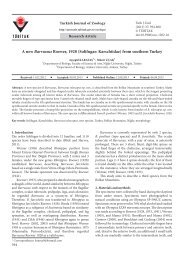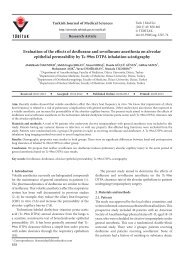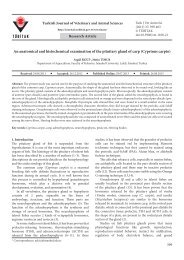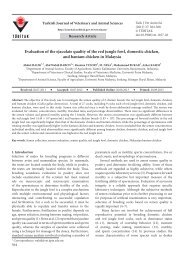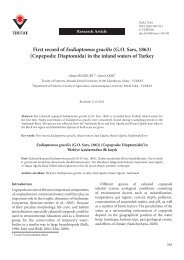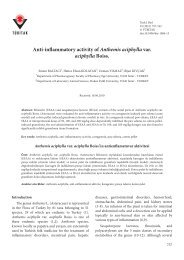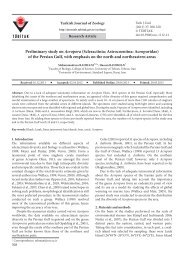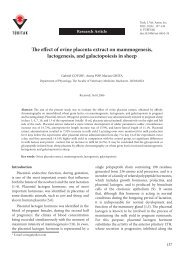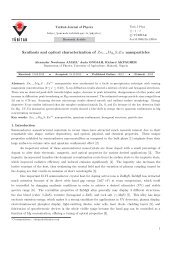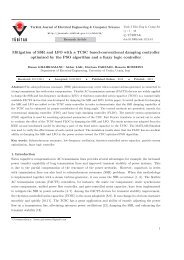(SbCl5 -SiO2): an efficient reagent for synthesis of 2,3,5-sub
(SbCl5 -SiO2): an efficient reagent for synthesis of 2,3,5-sub
(SbCl5 -SiO2): an efficient reagent for synthesis of 2,3,5-sub
Create successful ePaper yourself
Turn your PDF publications into a flip-book with our unique Google optimized e-Paper software.
Turkish Journal <strong>of</strong> Chemistry<br />
http://journals.tubitak.gov.tr/chem/<br />
Research Article<br />
Turk J Chem<br />
() : 1 – 6<br />
c⃝ T ÜB˙ ITAK<br />
doi:10.3906/kim-1210-32<br />
Synthesis <strong>of</strong> n<strong>an</strong>oparticle silica-supported <strong>an</strong>timony pentachloride (<strong>SbCl5</strong> -<strong>SiO2</strong>):<br />
<strong>an</strong> <strong>efficient</strong> <strong>reagent</strong> <strong>for</strong> <strong>synthesis</strong> <strong>of</strong> 2,3,5-<strong>sub</strong>stituted-2H-pyrazole derivatives<br />
Bahareh SADEGHI ∗<br />
Department <strong>of</strong> Chemistry, Yazd Br<strong>an</strong>ch, Islamic Azad University, P.O. Box 9195-155, Yazd, Ir<strong>an</strong><br />
Received: 14.10.2012 • Accepted: 30.01.2013 • Published Online: ..2013 • Printed: ..2013<br />
Abstract: N<strong>an</strong>ostructured SbCl 5 -SiO 2 has been prepared <strong>an</strong>d shown to <strong>efficient</strong>ly catalyze the one-pot reaction <strong>of</strong><br />
1,3-diketones <strong>an</strong>d hydrazines under solvent-free conditions, to af<strong>for</strong>d the corresponding 2,3,5-<strong>sub</strong>stituted-2H -pyrazole<br />
derivatives in excellent yields.<br />
Key words: SbCl 5 -SiO 2 n<strong>an</strong>oparticles, 1,3-diketones, hydrazines, 2,3,5-<strong>sub</strong>stituted-2H -pyrazoles, solid acids<br />
1. Introduction<br />
Heterocycles are popularly known <strong>for</strong> displaying a wide r<strong>an</strong>ge <strong>of</strong> biological properties. 1 The recent success <strong>of</strong><br />
pyrazole-based COX-2 inhibitors <strong>an</strong>d their applications in medicinal chemistry have amplified the import<strong>an</strong>ce <strong>of</strong><br />
pyrazoles to <strong>an</strong> even a greater extent. 2 Several pharmaceutical drugs including celecoxib 2 <strong>an</strong>d rimonab<strong>an</strong>t 3 uti-<br />
lize pyrazole as their core molecular entity. 4,5 Pyrazoles are <strong>of</strong>ten synthesized by the 1,3-dipolar cycloaddition re-<br />
action <strong>of</strong> nitrilimines with alkynes, 6 alkyne surrogates, 7 or alkenes. 5,6 Pyrazoles also c<strong>an</strong> be synthesized via 1,3-<br />
dipolar cycloadditions <strong>of</strong> diazo compounds; 8 reaction <strong>of</strong> chalcones 9 <strong>an</strong>d hydrazines; a 4-component coupling <strong>of</strong><br />
terminal alkynes, hydrazine, carbon monoxide, <strong>an</strong>d aryl iodides; 10 <strong>an</strong>d the direct condensation <strong>of</strong> 1,3-diketones<br />
<strong>an</strong>d hydrazines in the presence <strong>of</strong> <strong>an</strong> acidic catalyst. 11 The last one is the simplest <strong>an</strong>d most straight<strong>for</strong>ward pro-<br />
cedure <strong>for</strong> the <strong>synthesis</strong> <strong>of</strong> pyrazoles. A variety <strong>of</strong> the catalysts such as H 2 SO 4 , 12 polystyrene-supported sulfonic<br />
acid, 13 layered zirconium sulfophenyl phosphonate [a-Zr(CH 3 PO 3)1.2 (O 3 PC 6 H 4 SO 3 H) 0.8 ], 14 Sc(OTf) 3 , 15<br />
Y-zeolite, 16 <strong>an</strong>d magnesium perchlorate [Mg(ClO 4)2 ] 17 have been employed to affect this tr<strong>an</strong>s<strong>for</strong>mation.<br />
Application <strong>of</strong> environmentally benign solvent-free conditions <strong>an</strong>d solid acid catalysts represents a powerful<br />
green procedure. In this work, the application <strong>of</strong> a solid-phase acidic green n<strong>an</strong>ocatalyst has been investigated<br />
<strong>for</strong> the <strong>synthesis</strong> <strong>of</strong> 2,3,5-<strong>sub</strong>stituted-2H -pyrazole derivatives (Scheme 1).<br />
O O<br />
R 2 R 3<br />
R 4<br />
+ R 1<br />
NHNH 2<br />
SiO 2 -SbCl 5 N<strong>an</strong>oparticles<br />
Solvent-free,<br />
60 o<br />
C, 15 min<br />
1 2 3<br />
Scheme 1. Reaction between 1,3-diketones <strong>an</strong>d hydrazines catalyzed by n<strong>an</strong>oparticle silica-supported <strong>an</strong>timony pen-<br />
tachloride (SbCl 5 -SiO 2 n<strong>an</strong>oparticles) under solvent-free conditions.<br />
∗ Correspondence: bsadeghia@gmail.com<br />
R 2<br />
R 4<br />
N N<br />
R 1<br />
R 3<br />
1
2. Experimental<br />
SADEGHI/Turk J Chem<br />
Melting points were determined with <strong>an</strong> Electrothermal 9100 apparatus. Elemental <strong>an</strong>alyses were per<strong>for</strong>med at<br />
the <strong>an</strong>alytical laboratory <strong>of</strong> the Science <strong>an</strong>d Research Unit <strong>of</strong> Islamic Azad University. The morphology <strong>of</strong> the<br />
catalyst was observed using a VEGA SEM model (TESCAN) with <strong>an</strong> accelerating voltage <strong>of</strong> 15 kV.<br />
The chemicals used in this work were purchased from Fluka (Buchs, Switzerl<strong>an</strong>d) <strong>an</strong>d were used without<br />
further purification.<br />
2.1. Synthesis <strong>of</strong> SbCl 5 -SiO 2 n<strong>an</strong>ocrystals<br />
Antimony pentachloride (1 mL) was added dropwise over 10 min via a syringe to n<strong>an</strong>o silica gel powder (1 g)<br />
in 5 mL <strong>of</strong> dichlorometh<strong>an</strong>e at room temperature. The reaction mixture was then stirred <strong>for</strong> 30 min. Finally,<br />
the pale brown powder was separated <strong>an</strong>d dried at <strong>an</strong> ambient temperature <strong>for</strong> 2 h <strong>an</strong>d then stored in a dry<br />
container. The product was characterized by SEM (Figure).<br />
Figure. The SEM image <strong>of</strong> SbCl 5 -SiO 2 n<strong>an</strong>oparticles.<br />
2.2. General procedure <strong>for</strong> preparation <strong>of</strong> compounds 3a–3p<br />
A mixture <strong>of</strong> 1,3-diketones (2 mmol), hydrazines (2 mmol), <strong>an</strong>d SbCl 5 -SiO 2 n<strong>an</strong>oparticles (0.001 g) was placed<br />
in a round-bottomed flask. The materials were mixed <strong>an</strong>d heated at 60 ◦ C <strong>for</strong> 15 min. The progress <strong>of</strong> the<br />
reaction was followed by thin layer chromatography (n-hex<strong>an</strong>e : ethyl acetate). After the completion <strong>of</strong> the<br />
reaction, the mixture was filtered to separate the catalyst. After evaporation <strong>of</strong> the solvent, the crude product<br />
was recrystallized with hot eth<strong>an</strong>ol to obtain the pure compound.<br />
3. Results <strong>an</strong>d discussion<br />
In continuation <strong>of</strong> previous research on the use <strong>of</strong> solid acids in org<strong>an</strong>ic <strong>synthesis</strong>, 18−24 the <strong>synthesis</strong> <strong>of</strong> 2,3,5<strong>sub</strong>stituted-2H<br />
-pyrazole derivatives has been investigated by the condensation <strong>of</strong> 1,3-diketones <strong>an</strong>d hydrazines<br />
in the presence <strong>of</strong> SbCl 5 -SiO 2 n<strong>an</strong>oparticles as <strong>an</strong> inorg<strong>an</strong>ic solid acid. To optimize the reaction conditions,<br />
2
SADEGHI/Turk J Chem<br />
the reaction <strong>of</strong> 1,3-diphenylprop<strong>an</strong>e-1,3-dione <strong>an</strong>d phenylhydrazine was used as a model reaction to pyrazole<br />
<strong>synthesis</strong>. According to the obtained data, using the SbCl 5 -SiO 2 n<strong>an</strong>oparticles (0.001 g) under solvent-free<br />
conditions <strong>for</strong> the pyrazole <strong>for</strong>mation represents the best reaction conditions (Scheme 2).<br />
O O<br />
Ph Ph +<br />
Ph<br />
NHNH 2<br />
SiO 2 -SbCl 5 N<strong>an</strong>oparticles<br />
Solvent-free, 60 o C, 15 min<br />
Scheme 2. Reaction between 1,3-diphenylprop<strong>an</strong>e-1,3-dione <strong>an</strong>d phenylhydrazine catalyzed by SbCl 5 -SiO 2 n<strong>an</strong>oparti-<br />
cles.<br />
The stable catalyst was easily prepared <strong>an</strong>d used <strong>for</strong> preparation <strong>of</strong> 2,3,5-<strong>sub</strong>stituted-2H -pyrazole derivatives.<br />
To prove the better catalytic activity <strong>of</strong> SbCl 5 -SiO 2 n<strong>an</strong>oparticles, the reactions were studied with other<br />
catalysts under solvent-free conditions at 15 min, <strong>an</strong>d the results are listed in Table 1.<br />
Table 1. Reaction between 1,3-diphenylprop<strong>an</strong>e-1,3-dione <strong>an</strong>d phenylhydrazine in different catalysts <strong>an</strong>d under solvent-<br />
free conditions.<br />
Ph<br />
N N<br />
Entry Catalyst Time (min) Yield a (%)<br />
1 H2SO4 15 35<br />
2 Y-Zeolite 15 45<br />
3 Sc(OTf)3 15 83<br />
4 Zr(CH3PO3)1.2(O3PC6H4SO3H)0.8 15 70<br />
5 Mg(ClO4)2 15 80<br />
6 <strong>SbCl5</strong>-<strong>SiO2</strong> NPs 15 96<br />
7 PSSA ∗ 15 95<br />
8 - 15 10<br />
a Isolated yield.<br />
∗ Polystyrene-supported sulfonic acid.<br />
Table 1 clearly demonstrates that SbCl 5 -SiO 2 n<strong>an</strong>oparticles are <strong>an</strong> effective catalyst in terms <strong>of</strong> yield <strong>of</strong><br />
the obtained product.<br />
To find out the optimum qu<strong>an</strong>tity <strong>of</strong> SbCl 5 -SiO 2 n<strong>an</strong>oparticles, the model reaction was carried out at<br />
60 ◦ C using different qu<strong>an</strong>tities <strong>of</strong> SbCl 5 -SiO 2 n<strong>an</strong>oparticles (Table 2). According to the obtained data, 0.001<br />
g <strong>of</strong> SbCl 5 -SiO 2 n<strong>an</strong>oparticles gave excellent yield in 15 min (Table 2, entry 1).<br />
Table 2. Optimization amount <strong>of</strong> SbCl 5 -SiO 2 n<strong>an</strong>oparticles on the reaction <strong>of</strong> 1,3-diketones <strong>an</strong>d hydrazines at 60 ◦ C.<br />
Entry Catalyst (g) Time (min) Yield a (%)<br />
1 0.001 15 96<br />
2 0.0005 15 47<br />
3 0.0007 15 75<br />
4 0.0015 15 96<br />
a Isolated yield.<br />
The above reaction was also examined in various solvents (Table 3). The results indicated that different<br />
solvents affected the efficiency <strong>of</strong> the reaction. Most <strong>of</strong> these solvents required a longer time <strong>an</strong>d gave moderate<br />
yields, <strong>an</strong>d the best results were obtained when solvent-free conditions were used (Table 3, entry 5).<br />
Ph<br />
Ph<br />
3
SADEGHI/Turk J Chem<br />
Table 3. Solvent effect on the reaction between 1,3-diketones <strong>an</strong>d hydrazines catalyzed by SbCl 5 -SiO 2 n<strong>an</strong>oparticles<br />
(0.001 g).<br />
Entry Solvent Time (min) Yield a (%)<br />
1 CHCl3 15 55<br />
2 EtOH 15 80<br />
3 EtOAC 15 20<br />
4 n-Hex<strong>an</strong>e 15 10<br />
5 Solvent-free 15 96<br />
a Isolated yield.<br />
To study the scope <strong>of</strong> the reaction, a series <strong>of</strong> 1,3-diketones <strong>an</strong>d hydrazines catalyzed by SbCl 5 -SiO 2<br />
n<strong>an</strong>oparticles were applied. The results are shown in Table 4. In all cases, hydrazines <strong>sub</strong>stituted with<br />
either electron-donating or electron-withdrawing groups underwent the reaction smoothly <strong>an</strong>d gave products in<br />
excellent yields.<br />
Table 4. Reaction between 1,3-diketones <strong>an</strong>d hydrazines catalyzed by SbCl 5 -SiO 2 n<strong>an</strong>oparticles (0.001 g) at 60 ◦ C.<br />
Entry R 1 R 2 R 3 R 4 Product Yield % a<br />
mp (°C)<br />
Found<br />
Reported<br />
(Ref.)<br />
1 2,4-NO2C6H4 C6H5 C6H5 H 3a 96 148–149 149–150 17<br />
2 2,4-NO2C6H4 C6H5 CH3 H 3b 65 129–131 128–130 14<br />
3 2,4-NO2C6H4 CH3 CH3 H 3c 95 122–124 122–123 15<br />
4 2,4-NO2C6H4 CH3 CH3 Cl 3d 94 166–167 167–168 17<br />
5 C6H5 C6H5 C6H5 H 3e 92 138–139 137–138 16<br />
6 C6H5 C6H5 CH3 H 3f 90 56–58 55–57 15<br />
7 C6H5 CH3 CH3 H 3g 91 oil oil 15<br />
8 C6H5 CH3 CH3 Cl 3h 85 oil oil 13<br />
9 H C6H5 CH3 H 3i 80 204–205 203–205 12<br />
10 4-BrC6H4 CH3 CH3 Cl 3j 92 88–90 87–88 17<br />
11 4-BrC6H4 C6H5 C6H5 H 3k 90 118–120 117–119 17<br />
12 4-BrC6H4 C6H5 CH3 H 3l 89 175–177 178–180 17<br />
13 4-MeC6H4 C6H5 C6H5 H 3m 92 104–106 104–105 17<br />
14 4-MeC6H4 C6H5 CH3 H 3n 83 83–85 82–84 17<br />
15 4-MeOC6H4 C6H5 C6H5 H 3o 82 oil oil 17<br />
16 4-MeOC6H4 C6H5 CH3 H 3p 86 oil oil 17<br />
All products were known <strong>an</strong>d were identified by comparing their physical or spectral data with other<br />
literature. 12−17<br />
4
SADEGHI/Turk J Chem<br />
To examine the reusability <strong>of</strong> SbCl 5 -SiO 2 n<strong>an</strong>oparticles under solvent-free conditions, after each run the<br />
product was dissolved in CHCl 3 <strong>an</strong>d filtered to separate the catalyst, <strong>an</strong>d then the solid residue was dried. This<br />
process was repeated <strong>for</strong> 3 cycles <strong>an</strong>d the yield <strong>of</strong> product 3e did not ch<strong>an</strong>ge signific<strong>an</strong>tly (Table 5).<br />
Table 5. Recycling studies <strong>of</strong> reaction between 1,3-diphenylprop<strong>an</strong>e-1,3-dione <strong>an</strong>d phenylhydrazine in the presence <strong>of</strong><br />
SbCl 5 .SiO 2 n<strong>an</strong>oparticles to give product 3e.<br />
4. Conclusions<br />
Entry Cycle Time (min) Yield (%) a<br />
1 Fresh 15 92<br />
2 1 15 90<br />
3 2 15 89<br />
4 3 15 85<br />
a Yields refer to isolated products.<br />
In summary, SbCl 5 -SiO 2 n<strong>an</strong>oparticles have been synthesized <strong>an</strong>d it was shown that they have adv<strong>an</strong>tages in<br />
the preparation <strong>of</strong> 2,3,5-<strong>sub</strong>stituted-2H -pyrazoles, such as shorter reaction times, simple work-up, <strong>an</strong>d af<strong>for</strong>ding<br />
<strong>of</strong> excellent yields. The solid-phase acidic catalyst was reusable <strong>for</strong> a number <strong>of</strong> times without appreciable loss<br />
<strong>of</strong> activity. The present method does not involve <strong>an</strong>y hazardous org<strong>an</strong>ic solvent. There<strong>for</strong>e, this procedure<br />
could be classified as green chemistry.<br />
Acknowledgments<br />
The research council <strong>of</strong> the Islamic Azad University <strong>of</strong> Yazd is gratefully acknowledged <strong>for</strong> fin<strong>an</strong>cial support <strong>for</strong><br />
this work.<br />
References<br />
1. Shen, D.; Shu, M.; Chapm<strong>an</strong>, K. T. Org. Lett. 2000, 2, 2789–2792.<br />
2. Penning, T. D.; Talley, J. J.; Bertenshaw, S. R.; Carter, J. S.; Collins, P. W.; Docter, S.; Gr<strong>an</strong>eto, M. J.; Lee,<br />
L. F.; Malecha, J. W.; Miyashiro, J. M.; Rogers, R. S.; Rogier, D. J.; Yu, S. S.; Anderson, G. D.; Burton, E. G.;<br />
Cogburn, J. N.; Gregory, S. A.; Koboldt, C. M.; Perkins, W. E.; Seibert, K.; Veenhuizen, A. W.; Zh<strong>an</strong>g Y. Y.;<br />
Isakson, P. C. J. Med. Chem. 1997, 40, 1347–1365.<br />
3. Deng X.; M<strong>an</strong>i, N. S. Org. Lett. 2008, 10, 1307–1310.<br />
4. Katritzky, A. R.; W<strong>an</strong>g, M.; Zh<strong>an</strong>g, S.; Voronkov, M. V. J. Org. Chem. 2001, 66, 6787–6791.<br />
5. Deng, X.; M<strong>an</strong>i, N. S. Org. Lett. 2006, 8, 3505–3508.<br />
6. Huisgen, R. Angew. Chem. Int. Ed. Engl. 1980, 19, 947–973.<br />
7. Donohue, A. C.; Pallich, S.; McCarthy, T. D. J. Chem. Soc., Perkin Tr<strong>an</strong>s. 1, 2001, 2001, 2817–2822.<br />
8. Aggarwal, V. K.; Vicente, D. V.; Bonnert, R. V. J. Org. Chem. 2003, 68, 5381–5383.<br />
9. Bhat, B. A.; Puri, S. C.; Qurishi, M. A.; Dhar, K. L.; Qazi, G. N. Synth. Commun. 2005, 35, 1135–1142.<br />
10. Ahmed, M. S. M.; Kobayashi, K.; Mori, A. Org. Lett. 2005, 7, 4487–4489.<br />
11. Fustero, S.; Rom<strong>an</strong>, R.; S<strong>an</strong>z-Cervera, J. F.; Simon-Fuentes, A. X.; Cunat, A. C.; Vill<strong>an</strong>ova, S.; Murguia, M. J.<br />
Org. Chem. 2008, 73, 3523–3529.<br />
12. W<strong>an</strong>g, Z.; Qin, H. Green Chem. 2004, 6, 90–92.<br />
13. Polshettiwar, V.; Varma, R. S. Tetrahedron Lett. 2008, 49, 397–400.<br />
14. Curini, M.; Rosati, O.; Campagna, V.; Mont<strong>an</strong>ari, F.; Cravotto, G.; Boccalini, M. Synlett 2005, 19, 2927–2929.<br />
5
6<br />
SADEGHI/Turk J Chem<br />
15. Xiong, W.; Chen, J. X.; Liu, M. C.; Ding, J. C.; Wu, H. Y.; Su, W. K. J. Braz. Chem. Soc. 2009, 20, 367–370.<br />
16. Sreekumar, R.; Padmakumar, R. Synth. Commun. 1998, 28, 1661–1665.<br />
17. Mirjalili, B. F.; Bamoniri, A. H.; Amrollahi M. A.; Emtiazi, H. Dig. J. N<strong>an</strong>omater. Bios. 2010, 5, 897–902.<br />
18. Sadeghi, B.; Mirjalili B. F.; Hashemi, M. M. Tetrahedron Lett. 2008, 49, 2575–2577.<br />
19. Mirjalili, B. F.; Hashemi, M. M.; Sadeghi, B.; Emtiazi, H. J. Chin. Chem. Soc. 2009, 56, 386–391.<br />
20. Sadeghi, B.; Hass<strong>an</strong>abadi, A.; Bidaki, S. J. Chem. Res. 2011, 35, 666–668.<br />
21. Sadeghi, B.; Hass<strong>an</strong>abadi, A.; Taghvatalab, E. J. Chem. Res. 2011, 35, 707–708.<br />
22. Sadeghi, B.; Hass<strong>an</strong>abadi, A.; Kamali, M. J. Chem. Res. 2012, 36, 9–11.<br />
23. Sadeghi, B.; Zavar, S.; Hass<strong>an</strong>abadi, A. J. Chem. Res. 2012, 36, 343–346.<br />
24. Sadeghi, B.; Nasiri<strong>an</strong> Z.; Hass<strong>an</strong>abadi, A. J. Chem. Res. 2012, 36, 391–392.



